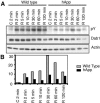Mouse disabled 1 regulates the nuclear position of neurons in a Drosophila eye model
- PMID: 16449660
- PMCID: PMC1367204
- DOI: 10.1128/MCB.26.4.1510-1517.2006
Mouse disabled 1 regulates the nuclear position of neurons in a Drosophila eye model
Abstract
Nucleokinesis has recently been suggested as a critical regulator of neuronal migration. Here we show that Disabled 1 (Dab1), which is required for neuronal positioning in mammals, regulates the nuclear position of postmitotic neurons in a phosphorylation-site dependent manner. Dab1 expression in the Drosophila visual system partially rescues nuclear position defects caused by a mutation in the Dynactin subunit Glued. Furthermore, we observed that a loss-of-function allele of amyloid precursor protein (APP)-like, a kinesin cargo receptor, enhanced the severity of a Dab1 overexpression phenotype characterized by misplaced nuclei in the adult retina. In mammalian neurons, overexpression of APP reduced the ability of Reelin to induce Dab1 tyrosine phosphorylation, suggesting an antagonistic relationship between APP family members and Dab1 function. This is the first evidence that signaling which regulates Dab1 tyrosine phosphorylation determines nuclear positioning through Dab1-mediated influences on microtubule motor proteins in a subset of neurons.
Figures







Similar articles
-
Interaction between Dab1 and CrkII is promoted by Reelin signaling.J Cell Sci. 2004 Sep 1;117(Pt 19):4527-36. doi: 10.1242/jcs.01320. Epub 2004 Aug 17. J Cell Sci. 2004. PMID: 15316068
-
Migration of sympathetic preganglionic neurons in the spinal cord is regulated by Reelin-dependent Dab1 tyrosine phosphorylation and CrkL.J Comp Neurol. 2007 Jun 1;502(4):635-43. doi: 10.1002/cne.21318. J Comp Neurol. 2007. PMID: 17394141
-
Relative importance of the tyrosine phosphorylation sites of Disabled-1 to the transmission of Reelin signaling.Brain Res. 2009 Dec 22;1304:26-37. doi: 10.1016/j.brainres.2009.09.087. Epub 2009 Sep 29. Brain Res. 2009. PMID: 19796633
-
Reelin-Disabled-1 signaling in neuronal migration: splicing takes the stage.Cell Mol Life Sci. 2013 Jul;70(13):2319-29. doi: 10.1007/s00018-012-1171-6. Epub 2012 Sep 28. Cell Mol Life Sci. 2013. PMID: 23052211 Free PMC article. Review.
-
A missed exit: Reelin sets in motion Dab1 polyubiquitination to put the break on neuronal migration.Genes Dev. 2007 Nov 15;21(22):2850-4. doi: 10.1101/gad.1622907. Genes Dev. 2007. PMID: 18006681 Review. No abstract available.
Cited by
-
Lipoprotein receptors--an evolutionarily ancient multifunctional receptor family.Biol Chem. 2010 Nov;391(11):1341-63. doi: 10.1515/BC.2010.129. Biol Chem. 2010. PMID: 20868222 Free PMC article. Review.
-
Abeta42-induced neurodegeneration via an age-dependent autophagic-lysosomal injury in Drosophila.PLoS One. 2009;4(1):e4201. doi: 10.1371/journal.pone.0004201. Epub 2009 Jan 15. PLoS One. 2009. PMID: 19145255 Free PMC article.
-
Interaction of reelin with amyloid precursor protein promotes neurite outgrowth.J Neurosci. 2009 Jun 10;29(23):7459-73. doi: 10.1523/JNEUROSCI.4872-08.2009. J Neurosci. 2009. PMID: 19515914 Free PMC article.
-
Pancortins interact with amyloid precursor protein and modulate cortical cell migration.Development. 2012 Nov;139(21):3986-96. doi: 10.1242/dev.082909. Epub 2012 Sep 19. Development. 2012. PMID: 22992957 Free PMC article.
-
Amyloid precursor proteins interact with the heterotrimeric G protein Go in the control of neuronal migration.J Neurosci. 2013 Jun 12;33(24):10165-81. doi: 10.1523/JNEUROSCI.1146-13.2013. J Neurosci. 2013. PMID: 23761911 Free PMC article.
References
-
- Arnaud, L., B. A. Ballif, E. Förster, and J. A. Cooper. 2003. Fyn tyrosine kinase is a critical regulator of Disabled-1 during brain development. Curr. Biol. 13:9-17. - PubMed
-
- Assadi, A. H., G. Zhang, U. Beffert, R. S. McNeil, A. L. Renfro, S. Niu, C. C. Quattrocchi, B. A. Antalffy, M. Sheldon, D. D. Armstrong, A. Wynshaw-Boris, J. Herz, G. D'Arcangelo, and G. D. Clark. 2003. Interaction of reelin signaling and Lis1 in brain development. Nat. Genet. 35:270-276. - PubMed
-
- Ballif, B. A., L. Arnaud, W. T. Arthur, D. Guris, A. Imamoto, and J. A. Cooper. 2004. Activation of a Dab1/CrkL/C3G/Rap1 pathway in Reelin-stimulated neurons. Curr. Biol. 14:606-610. - PubMed
-
- Bock, H. H., and J. Herz. 2003. Reelin activates SRC family tyrosine kinases in neurons. Curr. Biol. 13:18-26. - PubMed
Publication types
MeSH terms
Substances
Grants and funding
LinkOut - more resources
Full Text Sources
Medical
Molecular Biology Databases
